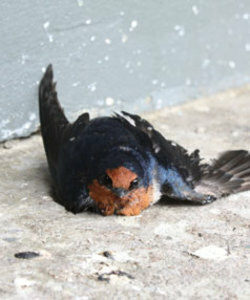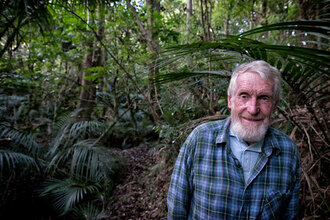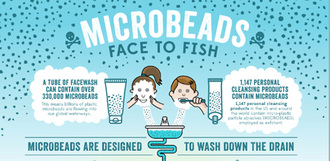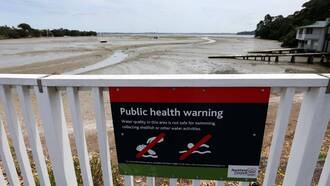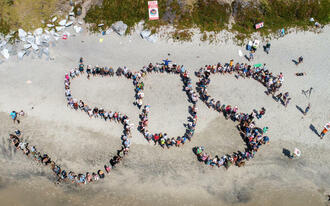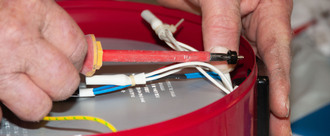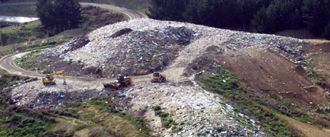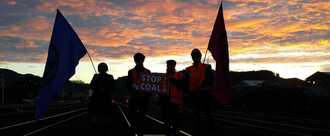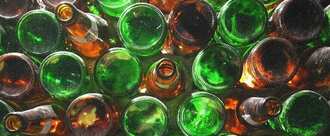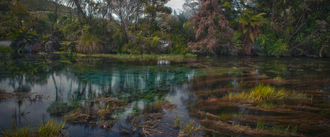-
Stop Hot Foot!Hot Foot and other polybutene based bird repellents are a cruel and inhumane method of pest control. It is a sticky glue like substance which burns on skin contact and can trap birds and small animals(1), literally gluing them to buildings! (2) It does not discriminate between native and non-native birds and the injuries that birds sustain may require them to be euthanised (3). Mitre 10 and the manufacturer of Hot Foot (Hot Foot International) claim that it does not harm birds but that is hard to believe when the product carries so many harsh health warnings for humans. For eye contact, you are supposed to flush with water for 20 minutes. For skin contact you are supposed to do the same and sponge the skin gently so the skin doesn't come off. If it's swallowed, it can burn the mouth, throat and stomach lining and they can't even pump your stomach so you're out of luck. (4) All of these things could happen to a bird who encounters the gel and tries to remove it by preening. Pest control does not have to be cruel. There are many products available on the market, even at Mitre 10, which do not cause any harm to the target animals. Spikes, nets, flash tapes, predator decoys and even similar non-toxic bio repellent gels are very effective and also humane. Hot foot is a barbaric product that has no place on Mitre 10's shelves--tell Mitre 10 to stop carrying Hot Foot today! --References-- 1. Hot Foot's own label details the risks of using the product: https://www.hotfoot.com/labels/gel-label.pdf 2. A sad story from Waikato in 2009 shows how a flock of native Welcome Swallows (Warou) were trapped against a pipe and unable to free themselves: http://www.stuff.co.nz/waikato-times/news/2774765/Bird-error-hard-to-swallow 3. A 2011 story from Nelson shows another incident where the majority of a flock of Welcome Swallows needed the be euthanised. Note the quote from Senior SPCA inspector Craig Crowley who says "I have never seen anything as horrible in pest control. It is unacceptable in any circumstances." http://www.stuff.co.nz/the-press/news/5256404/Distressing-sticky-end-for-trapped-swallows 4. This page details medical advice for emergency medical treatment. http://toxnet.nlm.nih.gov/cgi-bin/sis/search/a?dbs+hsdb:@term+@DOCNO+515885 of 100 SignaturesCreated by Ellen Ozarka

-
Save Graham's BushIndividuals, like Graham, who have been protecting the bush for years (and were paid subsidies by city councils to do this) are now finding out that their land is to be forceably taken from them, and their precious bush destroyed. The proposed route will bisect the water catchment that feeds Totara Park. There is already evidence that existing roading has damaged gullies of native bush in the area - this proposal would have a much greater negative impact. Grahams Bush is one of many on the proposed highway route. It has a number of significant trees and it is a site of ecological importance. Graham unfortunately died trying to save this bush last year during this fight. We want to honour his legacy and are are tired of Auckland Transport saying this is the 'cheapest' route. We say it is the most expensive - ecologically expensive and ridiculously planned in a way that makes no sense in the 21st century. Sign our petition to send a message that says NO to the proposed route and YES to being heard. If you want to read some ideas on alternatives please visit the site of GenZero or Auckland Transport Bloggers - they have suggested some excellent alternatives to fix Auckland's Transport Problems and for a lot less cost! For example: http://www.scoop.co.nz/stories/PO1503/S00036/launch-of-essential-transport-budget-generation-zero.htm7,223 of 8,000 SignaturesCreated by Eve Osbourne

-
Ban microbeads in New ZealandMicrobeads are small pieces of plastic that are found mainly in beauty products, facial scrubs and toothpaste. They have been proven to have a devastating impact on marine life and that they filter through the food chain and have an impact on human diets as well. They have even been found in sea salt. There is no practical way to clean them once they are in the ocean. Article 23 of the Waste Minimisation Act 2008 states that regulations may be put in place to prohibit the manufacture or sale of products that contain specified materials. We therefore call on Hon. Dr. Nick Smith to apply this article to plastic microbeads, including 'biodegradable' plastic microbeads and other similar products that will not break down in our oceans. https://www.beatthemicrobead.org/ Credit to 5Gyres for the picture.8,358 of 9,000 SignaturesCreated by Jake, Naomi, Briar, Sariya and Kaya

-
Stop the Poo-llution of Auckland’s urban waterways, beaches and coastal environmentThere is poo on our beaches! Auckland's waterways and beaches are seriously polluted by stormwater regularly contaminated by sewage, trade waste, heavy metals, toxins, chemicals, and oils thanks to years of inaction by the council, and fear of rate rises. We need urgent action so that New Zealanders can enjoy our urban waterways and beaches without fear of sickness or injury or swimming with poo and we protect our freshwater and marine organisms from pollution and destruction. We need action now, not in 10 years time. Give us back our beaches, estuaries, lagoons streams and rivers! This campaign is about raising peoples’ awareness of what is going on under our feet with inadequate infrastructure to cope with climate change and the massive intensification of Tamaki Makaurau, the Auckland region. So far there is almost a sole emphasis on rural areas and the problems intensive farming is causing to our rural waterways and lakes. This is really important. but so is the disgraceful state of many urban waterways and beaches where people are now regularly being told they cannot swim. There is a solution right now on the table the Council is avoiding - the government proposal for ‘three waters’ reform is perfect for Auckland specifically. The three waters are storm water, waste water, and drinking water. Through the proposal, Auckland can take advantage of Government funding to catch up on the needed upgrades and infrastructure spends. It will take politics out of the decisions and prioritise the health of the harbour and the people. Ngāti Whātua ki Orākei Iwi deputy chair, Ngārimu Blair and Council Mayor Phil Goff both sat on the working group for Three Waters reforms. Unfortunately Auckland’s Environment watchdogs do not - we are excluded. If there are concerns specific to Auckland region then let’s engage to adapt it for our region and make it work. We demand action now, not in 10, or 20 years time. Let’s revive our beaches, estuaries, lagoons, streams and rivers! By acting now we will revive the health of our freshwater and marine life, and the people’s health for generations to come. No more sewage or contaminated stormwater in our backyards and beach environments. We need to work together to clean this up - Māori, Pakeha, diverse communities, churches, community organisations, environmental groups, businesses, political parties, schools, and individuals. Kia kaha! Kia maia! Awhina mai! The Detail: How safe are Auckland's beaches from pollution? https://www.stuff.co.nz/national/the-detail/300217833/the-detail-how-safe-are-aucklands-beaches-from-pollution Nearly 40 Auckland beaches overwhelmed by faecal contamination, deemed unsafe for swimming https://www.newshub.co.nz/home/new-zealand/2021/04/nearly-40-auckland-beaches-overwhelmed-by-faecal-contamination-deemed-unsafe-for-swimming.html Government's Three Waters working group to include mayors Goff, Barry, Reese and Dalziel https://www.stuff.co.nz/national/politics/126951378/governments-three-waters-working-group-to-include-mayors-goff-barry-reese-and-dalziel720 of 800 SignaturesCreated by John McCaffery

-
Mangawhai Pakiri SOSPakiri & Mangawhai Beaches, two hours north of Auckland are natural treasures. People come to enjoy their glistening white sands, miraculous dunes, precious ecosystems and the rare species that make it their home. It is a taonga for generations to come. Yet for decades this area has been mined for its white sand. It’s the site of the largest single nearshore sand mining activity in the developed world. This sand extraction is causing erosion, threatening the sand-spit, destroying shellfish beds, stealing safe nesting spots from endangered birds and ruining surf breaks. It’s home to the Fairy Tern who nest in the sand dunes - only 40 are left now before they become extinct. Sand miner McCallum Brothers in seeking 3 consents to mine vast quantities of sand - 9 million cubic meters over a period of 35 years! To imagine how much this is, take a 1m cubed box of sand, line up 9 million of them - it’s the length of 6x New Zealand. We urgently need your support, if enough of us raise our voices we can send a powerful message to council that we want sand mining to stop. No other developed country allows nearshore sand mining – help to stop this madness and ensure guardianship of this beautiful coastline. Please: 1. Sign and share this petition to say no to sand mining of Mangawhai-Pakiri Embayment now! THANKS FOR YOUR SUPPORT Save our Sands (Mangawhai Harbour Restoration Society, Friends of Pakiri Beach, Te Whanau o Pakiri, Tangata Whenua, locals and concerned New Zealanders) are taking a stand and we need your help! This petition is in support of, and in partnership with the Friends of Pakiri Beach who are also collecting signatures and submissions here: https://our.actionstation.org.nz/petitions/save-pakiri-beach-from-sand-mining References: Pakiri locals fight plans to take their sand for Auckland beaches, RNZ, May 2021 https://www.rnz.co.nz/news/in-depth/441849/pakiri-locals-fight-plans-to-take-their-sand-for-auckland-beaches https://www.nzherald.co.nz/northern-advocate/news/ecologically-significant-mangawhai-sandspit-at-risk-from-sand-mining-northland-regional-council/BZCWODYKYBSOM2S6GOFPAHIPZU/9,935 of 10,000 SignaturesCreated by Save Our Sands
-
Make it our Right to RepairAre you frustrated that products aren’t made to last and when they break, they are not repairable? You are not alone! A 2020/2021 Consumer NZ survey of 5000 New Zealanders found that 76% of participants would rather get products repaired than throw them out and buy a new one By reducing product quality, and making products hard to repair, companies can sell stuff more cheaply. This fuels trends like ‘fast fashion, ‘fast furniture’ and ‘fast electronics’. As a result, our landfills are filling up, our climate is heating up, and every day we are wasting money replacing broken items that should be lasting far longer. Recycling alone isn’t enough to reduce the mountain of discarded stuff that ends up clogging our landfills. It doesn’t have to be this way! In the past, stuff was built to last, and there were skilled people throughout Aotearoa New Zealand who could repair your appliances, computer or furniture for a fraction of the cost of replacing them. Join us in calling on the Minister for the Environment to consider the following measures to make it easier and cheaper for people to get items repaired in Aotearoa New Zealand, and to turn the tide on the waste we create: 1. Pass laws that require products to last longer and be easier to repair Aotearoa New Zealand is behind many countries in the world when it comes to protecting the Right-to-Repair in law. We call on the Government to look to the best overseas examples of Right-to-Repair laws and pass our own laws in a short space of time, to ensure that products put on the market in New Zealand meet basic standards of durability and repairability. Laws need to ensure that spare parts are made available, and that independent repairers have access to the tools and information they need to fix broken items. Achieving good outcomes for repair requires changes to education, to consumer law, copyright law and waste minimisation law. We ask that the Government also promote circular product design and repair across the education sector, to ensure students are learning skills and mindsets to create sustainable technologies. 2. Take action to make repair services accessible and affordable for everyone We call on both central and local government to ensure equitable access and availability of repair services in communities across Aotearoa. In particular, actively supporting the growth of both for-profit and community-based repair services, and introducing reliable funding mechanisms for these businesses and organisations. Good tools for this job could include: targeted waste levy funding, subsidies for repair, providing free or low-cost physical spaces in cities and towns for repair hubs, and making sure that product stewardship schemes cover the costs of repair, as well as recycling. 3. Ensure consumers have access to information on product repairability and durability When purchasing products in Aotearoa, it can be difficult to tell whether a product is good quality or easily repairable, due to a lack of information. We call on the Government to support Consumer NZ in developing a labelling or certification scheme to be displayed on key products, such as electronics, furniture and textiles, so consumers know how long a particular product is expected to last. We would like to see Aotearoa adopt a ‘repairability index” (similar to the French one) so that people can see how easy it is to get an item repaired before they buy it. 4. Require producers to offer spare parts and repair services Under the Consumer Guarantees Act manufacturers need to provide spare parts and access to repair services for their products. However, if they let the consumer know at the point of sale that there are no spare parts or repair services then they can opt out of this provision. We urge you to amend the Consumer Guarantees Act so that no manufacturer can opt out of this. It's time to reclaim our right to buy durable products that are easy to repair. We want Government to hold producers and retailers responsible for the whole life-cycle costs of the products they put into the market.14,104 of 15,000 SignaturesCreated by Repair Café Aotearoa New Zealand
-
Protect our environment and community and close the Levin landfill in 2022While the Horowhenua District Council (HDC) has recently closed the landfill for six months to enable community consultation and address long-standing compliance issues, our campaign is far from over. The Council still has resource consent to operate on the site until 2037. While the landfill is temporarily closed our waste is being sent to Bonny Glen – a compliant landfill near Marton. We want to keep it that way! You can help by signing our petition to protect the Hōkio environment from harmful waste leaching from the Levin landfill. Your support will help us close this non-compliant landfill and repatriate the site which has been degrading the Hōkio environment for decades; leaching into groundwater, polluting the Hōkio stream, and the ocean. In a time of climate change - when communities are cleaning up rivers, lakes, waterways and toxic sites all over Aotearoa – the Hōkio environment deserves a reprieve. We’re Over It because we strongly support the concerns of local Māori who have been ignored and disrespected over the on-going abuse of their rohe for years. We’re Over It - because the Hōkio community is frequently subject to foul odours - with residents’ complaints to the Horizons Regional Council (HRC) not being taken seriously. We’re Over It because the Horizons Regional Council is not being ‘called out’ over its shoddy environmental monitoring of the landfill and the Horowhenua catchment. We’re Over It because the landfill is consistently in breach of a number of ‘resource consents’ to operate in an environmentally responsible manner. We’re Over It because the District Council is not transparent with ratepayers on how the landfill is run. Contrary to popular myth, this facility is running up debt, not making money for the district. Why should you care? Well, if you’re a Kāpiti or Horowhenua resident - it’s your rubbish so you need to know where it’s going and that it’s not damaging the environment. Even if it’s not your rubbish, you should be concerned that in the 21st century any New Zealand community is operating a landfill like this, on a flood plain in coastal sand dune country.422 of 500 SignaturesCreated by Allison Webber
-
Uphold Te Tiriti and Protect Pūtiki BayPūtiki is a taonga, a cultural repository, a wāhi tapu, a bay lined with pā sites on headlands, 500+ year old pohutukawa trees, a traditional kai moana gathering space. It is a landing site of Te Arawa and Tainui waka, therefore the ancestral waters of every Māori who whakapapa back to these waka. What do we stand to lose? 7.3 hectares; 8 football fields of ocean space within this taonga. This is the unprecedented ocean grab that our people are facing and resisting here at Pūtiki. We say kao to the spread of colonisation onto our moana against the desires of our Iwi and community. We say kao to the exclusion of Māori voice and mātauranga in order for resource consents to be pushed across the line which stand to build on top of the history of our people. To read more about both our kaupapa and the significance of Pūtiki Bay to not only all Māori, but also all New Zealanders, please refer to our petition, or alternatively, our Facebook page, our Instagram, or our twitter.7,039 of 8,000 SignaturesCreated by Protect Pūtiki
-
Increase water flow on Manuherikia RiverNew Zealand law stipulates a responsibility to protect and improve the health of our waterways. The role of the Otago Regional Council is to implement this policy. For too long, private profit-driven imperatives have exploited our fresh waterways, including the Manuherikia River. These have taken precedence over environmental guardianship and the legacy we leave to future generations. This has led to extreme degradation of the river including loss of biodiversity and habitat due to river levels dropping to the extreme, largely due to agricultural and horticultural irrigation through water allocations and the exploitation of water rights attached to historical gold-mining permits. We are well aware of the contribution farming makes to New Zealand’s economy. However, we are also well aware that the financial costs of environmental degradation caused by predominant farming practices, are never included in the financial equation. These costs will be borne by our children and grandchildren. (Mike Joy https://www.rnz.co.nz/news/on-the-inside/440120/polluted-waterways-why-are-we-subsidising-environmental-harm) Rather than posing river health and farming in an adversarial context, the better question to ask and explore is: what forms of farming are best aligned to optimum river health? Examples abound here in New Zealand and overseas (particularly Australia/see Charles Massy) of low input farming practices suited to dry land, drought-prone regions which are both sustainable and profitable, that maintain and improve soil health and structure, leading to improved water holding capacity, a decrease in soil erosion, and minimising the need for irrigation. (see also Alan Savory, James Rebanks, Bill Mollison, Masanobu Fukuoka to name a few). Such regenerative and organic approaches to land and resource management prove that environmental guardianship is entirely possible and can be compatible with agriculture and horticulture. The predominant extractive farming model is not sustainable in the short-term, and certainly not in the long-term. As responsible citizens, we must acknowledge that nature has limits, but within those limits, there is an abundance of space for innovative, visionary and long-term practical land and water use.173 of 200 SignaturesCreated by Water Watch Otago
-
Get KiwiRail off coalWe are running out of time. Global heating is happening now. This government has declared a Climate Emergency, committed to net zero emissions and to a fossil free state sector by 2025. Yet KiwiRail has to try to make a profit for its' government shareholding ministers by hauling coal. Coal is the worst climate-destroying fossil fuel on the planet. KiwiRail signed up to the Climate Leaders' Coalition in 2018. KiwiRail has committed to a low emissions economy. They have no moral right to keep hauling coal.414 of 500 SignaturesCreated by Rosemary Penwarden
-
We want a comprehensive bottle refund scheme for AotearoaAfter years of campaigning from community groups, waste minimisation experts and councils and with the backing of the Environment Select Committee, we are the closest we have ever been to having a Container Return Scheme (CRS) implemented in NZ! This scheme will have enormous benefits for our community, land and sea; higher recycling rates, more reuse, decrease in litter and green jobs for local people. But we need it to be done right. Right now, vested industry groups are trying to block a comprehensive CRS in New Zealand and have their products (such as glass) excluded. Read more about our campaign on the Kiwi Bottle Drive website and check out the longer version of our open letter cosigned with other zero waste groups and like-minded organisations.4,914 of 5,000 SignaturesCreated by Kiwi Bottle Drive
-
Save Te Waikoropupū Springs from the threat of synthetic nitrogenTe Waikoropupū Springs are a national and international taonga (treasure). The springs have some of the clearest water ever measured on earth. That clarity is under threat from rising nitrate pollution - the signature of industrial dairying. The main source of the pollution is dairy farms in the recharge area of the aquifer, which apply hundreds of tonnes of synthetic nitrogen fertiliser each year, mainly urea. For over three years Golden Bay volunteers have meticulously monitored nitrate levels at the Springs. The undeniable trend is upward. By September 2019 the levels were 30% up from 2016 - and rising. Increasing nitrate levels are a threat to the unique ecosystem of Te Waikoropupū Springs. Elevated nitrate levels create ideal growing conditions for ugly algal blooms and pond slime. Recently a mat of ‘filamentous green algae’ was observed by DOC at the Dancing Sands Spring. This contaminant is typically found in nitrate rich waters. Rising nitrate levels also threaten the tiny creatures (stygofauna) that create the sparkling clear water in the aquifer. Te Waikoropupū Springs are of immense cultural, ecological and spiritual importance to New Zealanders. They are a Wāhi Tapu (Sacred place) to Māori. They are visited by more than 90,000 people a year. The upward trend in nitrate readings is a call to urgent action! We the undersigned ask that Minister for the Environment David Parker and the New Zealand Government acts urgently to ban synthetic nitrogen fertiliser from the recharge area of the Arthur Marble Aquifer.17,746 of 20,000 SignaturesCreated by Kevin Moran

